Gateway ID49: Mixing the Bag
by Dustin Sklavos on September 23, 2010 2:46 AM ESTLow and Medium Gaming on the ID49C
The benchmarks we run in our gaming suite should provide some fairly interesting results, especially in placing the NVIDIA GeForce GT 330M's relative performance against the 325M and 335M. The 325M sports 48 "CUDA cores" and a 128-bit memory bus just like the 330M, but at lower clock speeds, while the 335M moves up on the food chain and uses a harvested GeForce GT 240 die, running at slightly lower clocks than the 330M but bumping up to 72 shader cores.
There's a caveat to these results, however: for StarCraft II we had to manually tweak the display drivers to get Optimus to work with it (before we did the game ran at a constant 4fps, which is slow even for Intel's HD Graphics.) Also, there seems to be a bug with Optimus in Left 4 Dead 2 using the latest 260.63 drivers, where setting the game to 4xAA results in a blank screen. Unfortunately, we couldn't get the ID49C to run L4D2 with 4xAA on the 258.96 drivers either, something which wasn't an issue on the ASUS N82Jv. Those test results—for our "High" preset—are mostly academic as the 330M really isn't powerful enough to be pushing anti-aliasing anyhow, but it bears mentioning nonetheless.
Of course, all of this is going to be rendered fairly meaningless soon enough: GeForce 400M series parts should start trickling in soon, and hopefully they'll bring the kind of performance improvements NVIDIA has desperately needed on the mobile front. Optimus is a great technology AMD just doesn't have a counter for right now, but AMD's mobile parts are generally faster in their given classes. Hopefully with the 400Ms NVIDIA will be able to give us everything: better performance, DX11 support, and better battery life thanks to Optimus.
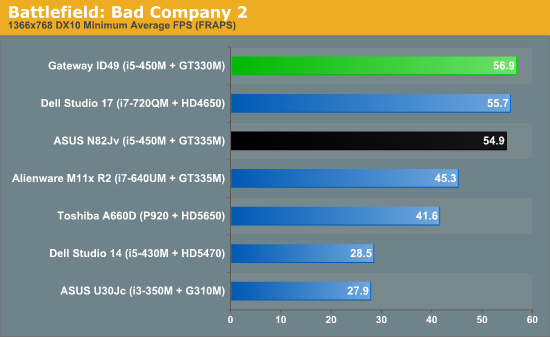
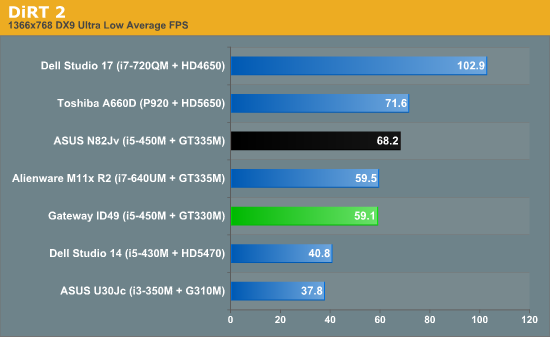
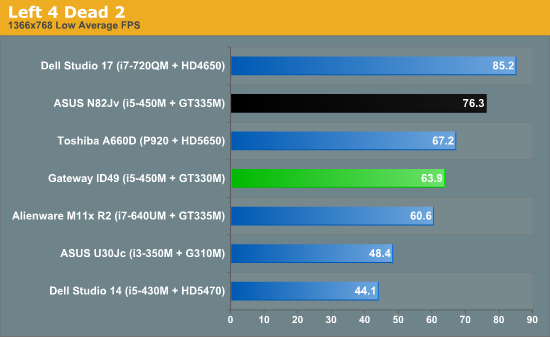
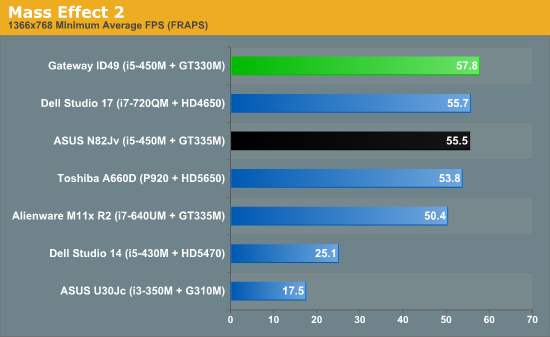
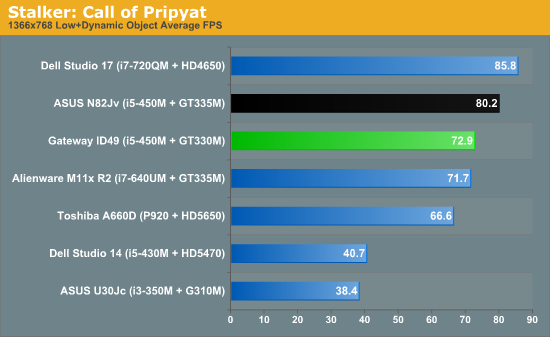
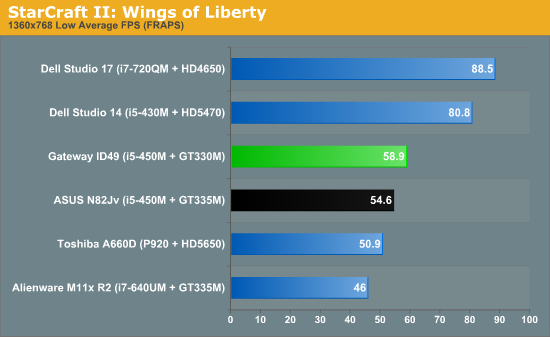
At these minimal settings, the GeForce GT 330M in the ID49C is able to post playable framerates on every game in our suite with room to spare. In most cases the testing units seem to be CPU limited, though the GeForce G 310M and Mobility Radeon HD 5470 are so anemic to begin with that even at minimal settings they threaten to bog down gaming performance. The exception is StarCraft II, where for whatever reason the Radeons seem to take it to the GeForces. The only Radeon not posting framerates over 80 is the HD 5650 in the Toshiba A660D, hamstrung by a slow Phenom II in a game traditionally CPU limited at even the highest settings. Also somewhat interesting is that the ID49C manages to best the GT 335M in the N82Jv in several games, despite sharing the same CPU. We'll see that once we up the quality settings, the GT 335M is able to take the lead.
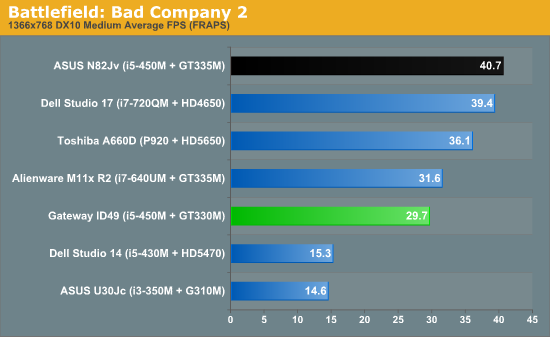
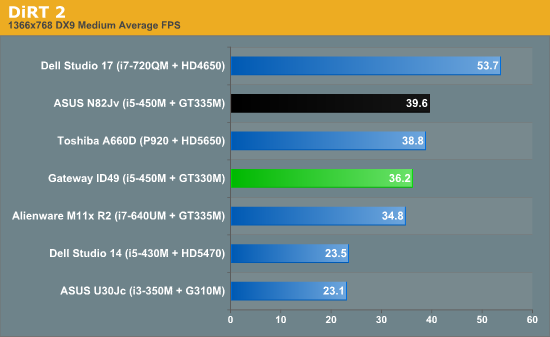

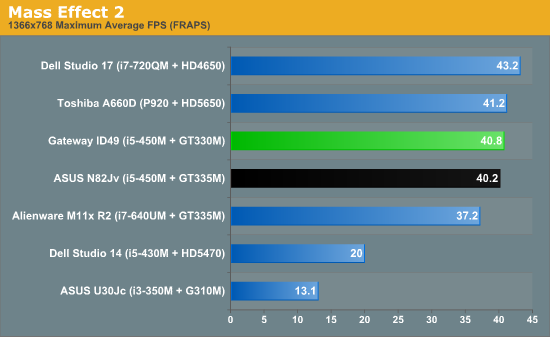
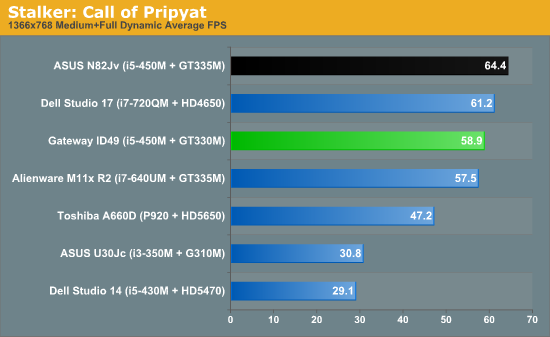
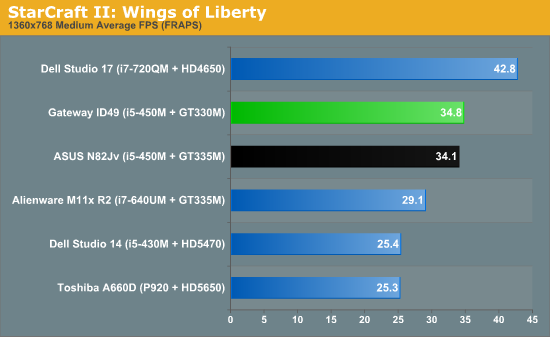
Once we start to ratchet up graphics settings, our testing suite starts to separate the men from the boys, and it's here that the GeForce GT 330M unfortunately exposes the weak link in Nvidia's current (and thankfully soon to be retired) mobile lineup. The GT 330M is extremely common, but it consistently loses to the Mobility Radeon HD 4650. The 4650 is an old chip; when it dropped it was an absolute powerhouse for the market segment, but it's been around for nearly two years, and Nvidia is only just now getting around to answering it with the 400M series. Even the GT 335M has problems with it.
Taken in a vacuum, the 330M is able to produce playable framerates in every game we tested it in, but it doesn't have much headroom. Its bigger brother, the 335M, and AMD's newer Radeon HD 5650 both come out looking pretty bad too. The 5650 proves itself as an incremental at best upgrade over the 4650, although it's important to keep in mind that the A660D is CPU-limiting it and worse, the 5650 itself is clocked 100MHz below spec in that unit. But the 335M, despite having a 100MHz slower clock speed has 72 shaders instead of the 330M's 48, and it still barely holds a lead, likely because both parts have the same memory bandwidth.










43 Comments
View All Comments
HibyPrime1 - Thursday, September 23, 2010 - link
Looking at the spec sheet, the visual layout of the laptop, and the price, I was actually quite interested in this one. Ugh.Back-lit trackpad but no back-lit keyboard? I want what they are smoking.
How much would it honestly cost to turn this into a usable keyboard? 5 cents worth of plastic under the keyboard to help a little with the flex, maybe a total of 2 engineering hours (come on, I could design that on a napkin), and a short conversation in a design meeting. That might increase the cost per laptop of a whole 10 cents. I'd be willing to let them charge me a 1000% percent profit on that.
To the authors of Anandtech, don't give up on the LCD bashing (when needed). Manufacturers need to hear it from somewhere.
vol7ron - Sunday, September 26, 2010 - link
I'm one of those people that don't need a backlit keyboard if it means cheaper.If necessary, the lighting from the screen should be enough; but mostly, I can't remember the last time I looked at a keyboard when typing. I don't even look at the iPhone on-screen keyboard anymore. My fingers are just used to the positioning and the second-nature of typing.
There are a few things that make the perfect laptop for me:
1) Price
2) CPU
3) GPU
4) Battery
5) Size
The other, still important factors include memory/hd capacity/performance and ports, but But backlit keys and glossy vsmatte aren't on my top-10 list.
xype - Thursday, September 23, 2010 - link
The more I read the reviews here, the more I think Apple's approach is smart on many levels—even though some people complain at the lack of diversity in their laptop lineup. If you have 3 models that differ in size mostly, "fixing" a keyboard means doing so once (especially since the keyboard is the same size/layout on all models). Fixing the screen on a, say, 13" means that, while some customers get screwed if they got an older model using a bad one, you're basically fixing the 13" model. No being left with a different model with a better screen, but perhaps a differently messed up keyboard.Sure, it doesn't please the geek in me to be able to choose the _optimal_ model, since with just 3 different ones (I'm buying MBPs) that are mostly the same, I'll have to compromise. But for Apple it's just so much more effective—and they can spend the time focusing on getting the 4 laptops they offer as "right" as they can.
Now, before someone accusses me of Apple fanboiism—perhaps I am one, but I'll freely admit that I know little of the product palettes of other manufacturers. The biased view I have is that each of them produces a ton of different models, trying to differentiate them with color covers and what not, and often get much less things "right" than they could get if they focused on making less models.
Also, I'd be interested to see the comparison tables include Apple laptops, where applicable, just because I'm interested in where other manufacturers do a better job so I can go compare them in the shop (I'm sometimes asked for buying advice and yapping "get a mac!" all the time is not something I want to do if there are better alternatives out for a budget/need).
Dustin Sklavos - Thursday, September 23, 2010 - link
Honestly, I know Anand and Brian both use MacBook Pros and having seen them in action I can understand why: the MBP has an excellent combination of form factor and screen quality. The screens on those are among the best I've seen on notebooks, high-resolution screens with great uniformity and viewing angles that are clearly designed for work.I'm not an Apple fan, I don't like their politics, and the desktop Macs are a rip-off in my opinion, but credit where credit is due...they make awesome notebooks.
xype - Thursday, September 23, 2010 - link
I've been pretty happy with MacBook(Pro)s for the past 4.5 years, but without a relative comparison the comparison tables just draw a blank stare from me. So I've wondered how they compare—of all the colleagues and friends, there's not one using a PC laptop, since we're all in the same lame-hipster-web-app-and-design business... so if you say they're among the better/best screens, I'm gonna go with your experience on this. :)vol7ron - Sunday, September 26, 2010 - link
Apple has historically only targeted the high-midend market, not cutting edge technology, but not the economy scale either.While this is good for Apple, if everyone had a business model like this, there wouldn't be anyone competing at the upper-and-lower end spectrums; the lower-lower and lower-middle end is where the majority of the market is.
Because Apple focuses on a niche market, they charge more. More importantly, they focus more on aesthetics and emotional marketing - trying to sell you something beyond performance/options, which is generally meaningless.
There are products that are less expensive and kick Apple's hind-side in almost everything except battery, which is partly due to the battery technology Apple uses, and the fact that Apple uses a Linux-based OS.
vol7ron - Sunday, September 26, 2010 - link
In general, given the same $$, you can get better performance elsewhere when compared to Apple.What you can't get is that "elitist" social recognition. ... It used to be that you also bought that superior casing that Apple is known for, but many companies are now offering artsy, slim, and sleek packaging that competes nicely.
Dustin Sklavos - Monday, September 27, 2010 - link
While I agree that there's a certain "my computer's better because it's a Mac" mentality that's prevalent among Mac users, in the case of the MacBook Pro line...I still don't think you're going to find a more balanced design anywhere else. The screens on those notebooks are phenomenal. Someone else brought up HP's Envy line, and those can probably compete, but I can't think of anyone else who produces mainstream notebooks with quality, high-resolution screens.For what it's worth, I reviewed here the two laptops I use, and my desktop is a custom. I won't spend a dime on Apple technology. But I can see why some people would go for a MBP.
Ivan Karkour - Monday, September 27, 2010 - link
Dell competes perfectly with the XPS 16, and the Adamo, but Adamo is kinda pricey.The Studio XPS 16 has the exact same screen as the mac book pros have. --and guess what, it's a little less expensive :)
seanleeforever - Thursday, September 23, 2010 - link
MBP's screen are decent, but no where near the best in term of "high-res" and "uniformity" and "view angel".go check out any lenovo tablet, any HP dreamcolor 2, or fujitsu T5013 tablet for that matter.. (they are all pretty expensive (1.6k~4k) and are never on display in BestBuy, so i won't be surprised that none of you guys actual saw it in your life, especially if you are student that are not targeted audience).
just because you are in "lame-hipster-web-app-and-design business" doesn't mean you need a good screen. apples' screen is 6 bit TN for god sake, the same part that used in NUMEROUS windows PCs (Dell M4500, Lenovo T/W510, W701/ds, Dell Studio XPS 16)... your argument is akin to say the Core 2 Duo used in Mac Book Pro must be faster than i7-960 because it was in a apple package.